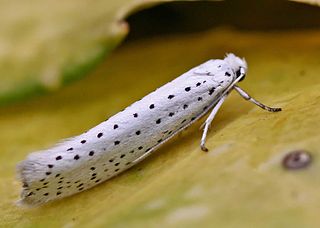
The family Yponomeutidae are known as the ermine moths, with several hundred species, most of them in the tropics. The larvae tend to form communal webs, and some are minor pests in agriculture, forestry, and horticulture. Adult moths are minor pollinators.
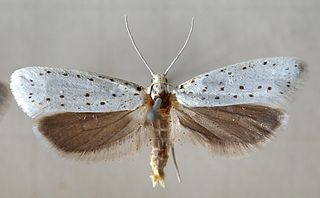
Yponomeuta cagnagella, the spindle ermine, is a moth from the family Yponomeutidae, the ermine moths. The wingspan of the moth ranges from 19 to 26 millimetres. The head is white. Forewings are white; four longitudinal series of few black dots, first not reaching middle, second beginning near before middle, lowest including 4-7 dots; some additional black dots before termen; cilia white. Hindwings are dark grey. The larva is pale greyish-yellowish; spots black; head black.

Argyresthia pruniella, the cherry fruit moth or cherry blossom tineid, is a moth from the family Yponomeutidae, the ermine moths.
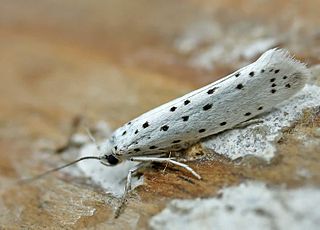
Yponomeuta padella is a lepidopteran from the family Yponomeutidae, the ermine moths. It is also known as the cherry ermine

Argyresthia albistria is a moth of the family Yponomeutidae. It is found in most of Europe.
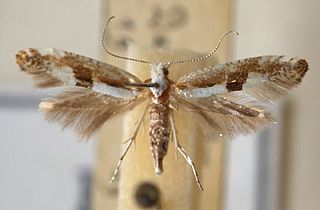
Argyresthia bonnetella is a moth of the family Yponomeutidae. It is found in Europe. The wingspan is 9–11 mm. The head is white. Forewings are shining ochreous-whitish, usually strigulated and sometimes discally suffused with ferruginous brown; a suffused ferruginous -brown median longitudinal streak from base to before middle; a curved dark ferruginous- brown fascia from middle of dorsum to 4/5 of costa, sometimes obsolete except on dorsum. Hindwings are grey. The larva is yellow-green; head and plate of 2 brown.
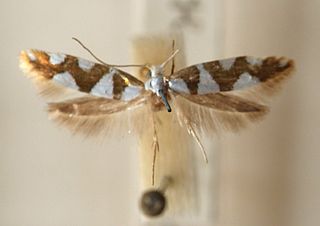
Argyresthia brockeella is a moth of the family Yponomeutidae. It is found in Europe, east Siberia and Japan. The wingspan is 9–12 mm. The head and thorax are white. Forewings are deep coppery-golden; a spot on base of dorsum, a fascia at 1/3, three posterior semioval costal spots and a larger tornal spot shining white; sometimes the fascia is connected with adjacent costal and dorsal spots. Hindwings are grey. The larva is pinkish-brown; head brown; plate of 2 partly blackish-edged.

Argyresthia curvella is a species of ermine moth. It belongs to subfamily Argyresthiinae, which is sometimes elevated to full family rank in the superfamily Yponomeutoidea. It is commonly called apple blossom tineid, reflecting the fact that it was originally believed to be a tineid moth.
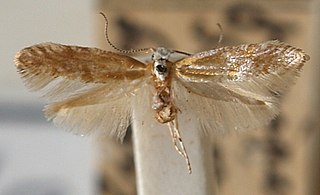
Argyresthia dilectella is a moth of the family Yponomeutidae. It is found in Northern Europe and Central Europe.

Argyresthia semitestacella is a moth of the family Yponomeutidae. It is found in Europe.

Argyresthia spinosella is a moth of the family Yponomeutidae. It is found in Europe and Anatolia.

Argyresthia trifasciata, the juniper ermine moth, is a moth of the family Yponomeutidae. It is found in great parts of Europe, but originates from the Alps. The forewings are shiny golden-brown with 3 silver-white transverse bands The moth flies from May to September. .

Argyresthia conjugella, the apple fruit moth, is a moth of the family Yponomeutidae. It is found in Europe, Siberia, Central Asia, Japan, and North America.
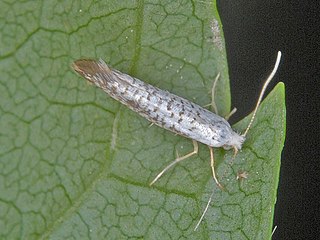
Argyresthia retinella is a species of moth of the family Yponomeutidae.
Argyresthia arceuthina is a moth of the family Yponomeutidae. It is found in Europe.

Argyresthia glaucinella is a moth of the family Yponomeutidae. It is found in Europe.

Coleophora versurella is a moth of the family Coleophoridae. It was described by Philipp Christoph Zeller in 1849.

Coleophora betulella is a moth of the family Coleophoridae. It is found in all of Europe, except the Balkan peninsula.

The metallic coleophora moth is a moth of the family Coleophoridae. It is native to Europe and Armenia, but is an adventive species in the Nearctic realm, where it is found throughout the United States and southern Canada. It has also been recorded from New Zealand, Chile and Argentina.
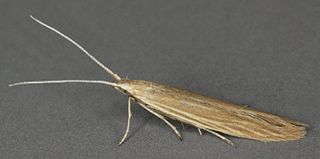
Coleophora tamesis is a moth of the family Coleophoridae found in Asia and Europe.



















